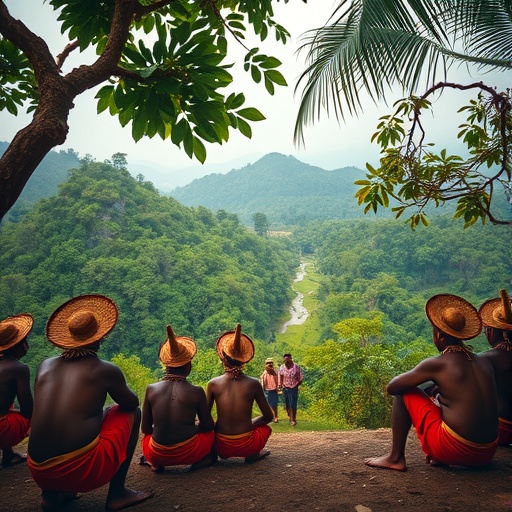In the remote hills of the Theni District, nestled within the verdant landscapes of Kadamalaikundu, a compelling ethnomedicinal study has emerged, shedding light on the profound botanical knowledge preserved by the Paliyar tribe. This research, recently published in the International Journal of Anthropology and Ethnology, offers a detailed and technical exploration of the traditional medicinal practices maintained by the Paliyar people. Their rich heritage of utilizing endemic plant species for therapeutic purposes not only underscores a deep cultural connection with nature but also presents potential avenues for novel pharmacological discoveries.
The ethnomedicinal survey meticulously documents the diverse plant species employed by the Paliyar tribe in treating a spectrum of ailments ranging from common inflammatory conditions to more complex systemic disorders. Researchers employed rigorous field methodologies, combining direct participant observation with semi-structured interviews. This approach ensured the comprehensive capture of indigenous knowledge that has been transmitted orally across generations, thereby safeguarding the contextual integrity of each plant’s medicinal application. Such integrative research methods enhance the reliability of ethnobotanical data and facilitate a nuanced understanding of indigenous pharmacopeias.
One of the pivotal facets of this survey is the identification and characterization of endemic plant species whose bioactive compounds remain largely unexplored in modern medicine. The Paliyar people’s selection criteria for medicinal plants emphasize not only therapeutic efficacy but also ecological availability and cultural symbolism. This triadic selection criterion reflects a sophisticated ethnobiological framework wherein ecological stewardship and cultural continuity converge, offering an instructive example for sustainable utilization of biodiversity in ethnopharmacology.
The therapeutic repertoire of the Paliyar notably includes botanicals targeting inflammatory pathways and microbial infections—conditions often prevalent in the tribe’s environment due to climatic and socio-economic factors. Preliminary phytochemical analyses conducted parallel to the ethnographic work reveal the presence of flavonoids, alkaloids, and terpenoids in several documented species. These compounds exhibit demonstrable anti-inflammatory and antimicrobial activities in vitro, providing a biochemical rationale for traditional usage and a promising foundation for future drug development.
Furthermore, the survey illuminates the intricate preparation methods used to optimize the efficacy of plant-based remedies. The Paliyar employ techniques such as decoction, maceration, and fermentation, which not only facilitate the extraction of active constituents but may also enhance bioavailability and stability. These traditional pharmaceutical practices, often overlooked by conventional pharmacology, warrant systematic study to uncover their mechanistic underpinnings and potential applications in contemporary herbal medicine formulations.
The cultural context surrounding medicinal plant use is intricately woven into the Paliyar’s holistic worldview, wherein health is perceived as a dynamic equilibrium between the human body, social structures, and natural environments. Ritualistic practices and spiritual invocations accompanying treatment underscore the psychophysiological dimensions of healing, suggesting that ethnomedicinal efficacy may be mediated through multifaceted pathways encompassing psychosomatic and neuroimmune interactions.
Socio-environmental dynamics impacting the Paliyar’s ethnomedicinal practices also receive thorough examination in this study. Accelerating environmental degradation, pressures from modernization, and shifts in livelihood patterns threaten the fragile transmission of indigenous knowledge systems. The researchers advocate urgent conservation strategies that integrate community participation, ethnobotanical education, and sustainable harvesting protocols to preserve both biological resources and intangible cultural heritage.
By incorporating geospatial analysis, the study maps the distribution of medicinal plant populations relative to anthropogenic influences and ecological gradients, enabling identification of conservation priority zones. The integration of ethnobotany with spatial ecology exemplifies an interdisciplinary approach vital for developing holistic strategies that reconcile human needs with environmental stewardship.
The implications of this ethnomedicinal survey extend well beyond academic boundaries. Pharmaceutical industries stand to benefit immensely from bioprospecting ventures grounded in ethnobotanical intelligence, potentially leading to the development of novel therapeutic agents derived from indigenous botanicals. However, the study also highlights the ethical imperatives of biopiracy prevention, advocating compliant frameworks for equitable benefit-sharing and intellectual property rights that respect indigenous sovereignty.
Moreover, the documentation process itself empowers the Paliyar community by validating their traditional knowledge within scientific paradigms, fostering opportunities for community-driven healthcare initiatives. Such integration of traditional medicine into primary health infrastructure could contribute significantly to culturally sensitive, accessible healthcare in rural and indigenous populations.
The research thereby serves as a critical reminder of the urgency to document and preserve ethnomedicinal wisdom before it risks irretrievable loss. As global biodiversity and cultural diversity face unprecedented threats, studies like this underscore that preserving indigenous knowledge is not only a scientific imperative but also a moral obligation toward sustaining human heritage and promoting biocultural resilience.
In conclusion, the ethnomedicinal survey of the Paliyar tribe conducted in Kadamalaikundu represents a seminal contribution to the fields of ethnobotany, pharmacology, and cultural anthropology. By bridging indigenous epistemologies with scientific inquiry, it opens pathways for innovation while affirming the value of ancestral knowledge systems. The continued collaboration between indigenous communities and researchers holds the promise of unlocking nature’s pharmacopeia in ways that are ethically sound, ecologically sustainable, and culturally respectful.
As the global scientific community seeks new solutions to persistent health challenges, embracing the complexity and profundity of traditional medicinal knowledge like that of the Paliyar tribe offers a powerful paradigm shift. This ethnomedicinal exploration reminds us that the answers to tomorrow’s medical mysteries may well lie in the interwoven roots of ancient forests and the wisdom of those who have long lived in harmony with the Earth.
Subject of Research:
Article Title:
Article References: Divya, C., Paul, M., Lata, C. et al. Ethnomedicinal survey of the Paliyar tribe: a case study of Kadamalaikundu, Theni District. Int. j. anthropol. ethnol. 8, 15 (2024). https://doi.org/10.1186/s41257-024-00116-4
Image Credits: AI Generated
DOI: 30 September 2024
Keywords:




